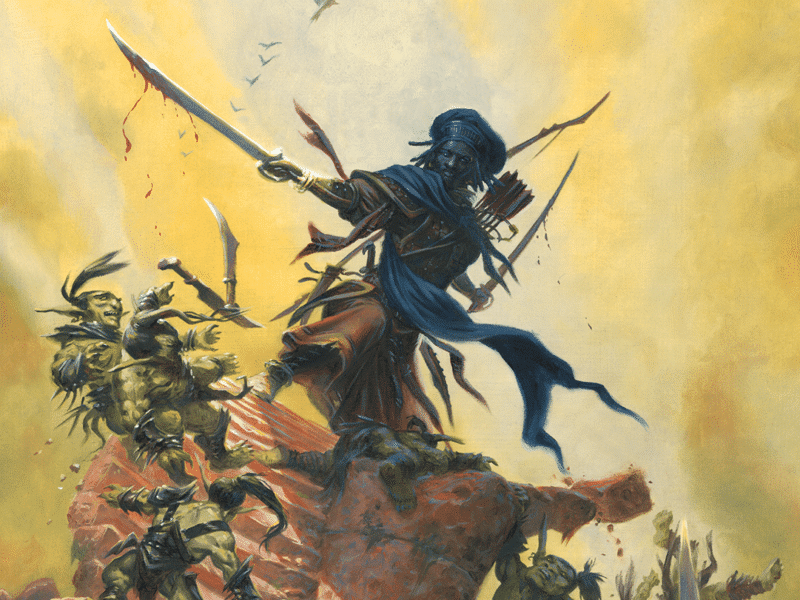This article is the last (and probably most spectacular) in the series that discusses ways to run Dungeons & Dragons to the greatest effect in various environments. To date, we’ve talked about all the most common places in which quests in D&D take place – forests, towns, deserts, tunnels, seas, and even the air. We’re ending this run with delving into the most fabulous and wild settings that playing D&D has in stock: its myriad planes of existence beyond the material plane. So unroll your flying carpets, open up the portals, and let’s zip off to the locations where everything unexpected can – and often will – happen!

At the heart of it, Dungeons & Dragons is a game of stark contrasts. On one hand, its default setting is a fairytale take on a medieval world heavily inspired by J.R.R Tolkien’s The Lord of the Rings, as well as lots of other fantasy novels and films. There are vast woods and dark tunnels in which monsters, wondrous beings and ancient secrets hide. There are small towns with busy markets and loud merchants, and cozy inns where fires burn bright in the hearths and the jugs are overflowing with ale.
Most of what the adventurers see is familiar, and it doesn’t take more than a curious statue or a strange light to spark a sense of wonder and mystery. This is typically the situation for new characters that set out in the world with only one level of experience under their belts, and quite often, their quests take place on the Material Plane – also known as the real world, in which things like gravity and time work much like on planet Earth.
On the other hand, the core rulebooks and many of the official adventures are rammed with locations rangeing from small areas to whole worlds that are intensely different and vastly more dangerous than the one we’re used to. These places are known as other planes – effectively, different dimensions – and they’re often characterised by specific aspects that give them a disntict theme that usually is connected to an alignment. There are tranquil planes on which travellers may wander and explore without facing many dangers, but there are many other planes that are exceedingly dissimilar to the Material Plane and on which adventuring can be a major hurdle.
On some planes, even travelling a few feet can be lethal; because of their volatility or general tipsy-turviness, and other planes are so riddled with dangerous creatures that most adventurers become midday snacks before they have time to find their bearings. These planes are naturally best suited for high-level characters, who are well equipped to handle threats that would turn less experienced heroes into mush in an eyeblink.
However, many planes, regardless of their overall theme and alignment, have lots of things in common (such as that they can be great fun for players and DMs alike to explore). Here below are some thoughts on what’s worth bearing in mind when considering to run a side trek, an adventure or an entire campaign on a different plane.
They’re hard to run
The adventures, that is – not the planes themselves (although one can imagine that Asmodeus has a hard time managing the legions of devils that crawl around the Nine Hells! Then again, devils are usually lawful, so they’re probably easier to keep in line than the infamously chaotically aligned demons of the Abyss…).
To get back on track: adventures set on any plane other than the Material Plane can be a challenge to prepare and run. Given that the characters (and, more importantly, the players) suddenly don’t have the same frame of reference that they’re used to, they’re likely to do things that prompt questions or thought – or they might even come up with them before you expect it.
For example, let’s say that the adventuring party has stumbled through a sinister-looking portal and find themselves in Shadowfell (basically a realm that by and large mirrors the Material Plane, but in which everything has a dark, negative and brooding taint to it). They’re now in an unfamiliar environment in which all the see can be questioned – and rightly so. They might ask if the ground feels intact, if the shadows in a tunnel look too restless, if the sky is showing signs of worsening weather, and so on. They might check their rations for hints of corruption every time they pause to eat, or they might spend hours deciding on a spot to strike camp because they’re nervous about, well, the whole place.
This means that the DM is wise to offer means to distinguish between what’s safe and what’s not. Ways to do this includes not springing nasty surprises on the party that are completely unexpected and irrational, or repeatedly tricking the characters into doing things that are harmful to them. It’s better to establish a general sense of otherness – in the case of Shadowfell, a menacing and ominous ambience – and then introduce various challenges that are clearly meant to be examined.
This makes for a more enjoyable game that’s far less time-consuming than having to explain the nature of every single item in sight. Obviously, how smoothly this works depends to a great extent on the nature of the people who are playing – if there’s any sense of mistrust between the players and the DM, an alien environment is likely to bog the session down to a crawl (and not a fun one!). Then again, if the adventurers insist on wandering off to poke at all that’s strange to them in this new place, then it’s perfectly fine to let them face a few (again, in the case of Shadowfell, foul and unpleasant) surprises.
What’s more, adventures on other planes require plenty of preparation to work well. If the DM lack a good description of the place that goes much further than “it’s like a mountain, but really big and, uh, steep,” or if they don’t have clue what kind of people and creatures that inhabit the plane, they might have to do a tremendous amount of inventing stuff on the spot – not always ideal as spur-of-the-moment-notions can become hard to keep track of, and also end up a little erratic.
They’re wild
This might be the key point about adventuring on planes beyond the run-of-the-mill material one. In short: if a quest has taken the adventurers to a new dimension through a portal or by some other means, everyone around the table is likely to expect radically new sights and some serious rollercoaster adventuring – or at the very least, a hint of utterly strange beings and fantastic phenomena that are nowhere to be seen on their native plane (unless they hail from a different plane, of course – but let’s ignore that).
For example, no one who enters the plane of Arcadia – a peaceful dimension known to be full of rugged, pristine natural land and lots of wildlife, and which largely resemble the Material Plane – expects to encounter the same kind of birds and other animals that one might find in a wood just behind the village in which the characters grew up. No one would anticipate the mountains to look just like the ones visible from the aforementioned village, or that the clouds are identical to those on the Material Plane. Not even slight changes cut it: merely making hawks and moose a bit bigger, the clouds somewhat puffier or the mountains slightly steeper isn’t sufficient. This is a completely different world, and it should stand out as such.
This is notable in Arcadia in many ways. For example, flora and fauna alike are tinted with metal – yes, all of it! – in bright and obvious ways. Also, the animals are cleverer than those on the Material Plane, and they have one-coloured eyes that can see right through illusions. And as if that wasn’t enough, the plane is populated by spirits! Just like that, and the world feels far more different and extreme than the Material Plane. So make sure to emphasise all that’s new and surprising in the plane that you take your players’ characters to. Even cases of exaggeration is fine, just to drive home the point that the heroes are far from home.
They’re magical
Most planes that are found outside the Material Plane are also characterised by a stronger presence of magic. That’s no wonder, as their existence in and of itself is enchanted – these locations, be they the size of a field or virtually endless, are extradimensional, which kind of is shorthand for magical. So don’t hold back on the arcanely astonishing when you’re describe the plane on which the adventurers have arrived, as the heightened presence of the magic weave of D&D will ramp up the sense of marvel and raise the anticipation of a grand adventure around the corner.
Many planes (or at least adventures set on different ones) highlight this aspect by letting magic – items, spells, potions etc – have peculiar and sometimes unwanted side effects when they’re used. I’d strongly recommend that there’s at least a small chance that magic “misbehaves” when it’s used on another plane. It can even be in a positive way that benefits the party! There are quite a few lists of suggested random effects available online, so take a look and consider what you might want to do to underscore that the plane is imbued with magic currents.
They’re full of life
Nothing is more boring than an empty pub that’s void of noise or song and filled with silence instead. That’s true about other planes too, so don’t fall into the trap of leaving your marvellously detailed and phenomenally vivid new world unpopulated. While levitating rocks and upside-down mountains are fun to include, it’s the creatures and the people that the characters will remember best.
So how to best add NPCs and other living things to a different plane? The core rulebooks aren’t particularly helpful here, as they’re very short on granular descriptions of each plane. Players of D&D have been asking and hoping for a new Manual of the Planes, the brilliant sourcebook that was mightly popular for an ealier edition of the game, but so far DMs can rely only on the content found in various adventures and other modules. However, there’s nothing stopping us for homebrewing – and as other planes are inherently magical and largely undefined by the current edition, they’re wide open to all kinds of ideas! In other words, go head and fill them with individuals that make sense, which means let yourself be inspired of the real world as well as the strangeness of the plane. There might be street vendors, shephers, farmers, scholars, soldiers, knights, royalty, traders, hunters – and, of course, regular adventurers, whoh know nothough about that strange “Material Plane” from which the newcomers (the charcaters) have travelled.
And where there’s intelligent life, there are schemes and intrigues! Few things make a place seem more real than a few feuds, arguments, secrets and hidden agendas. And these too have be shaped to fit the plane. Should the heroes have journeyed to the Abyss, they might end up caught in the middle of two opposed armies of demons. Or if it’s all about order and perfection, there might be individuals who hire the adventurers to root out a tribe of chaotic creatures that are upsetting the tidiness).
They’re dangerous
As mentioned above, planar adventures are especially well suited for characters who are experienced and in tier 3 – 4 (in other words, level 11 and above). Not that every single creature or NPC on different planes must be lethal in the extreme, but the sheer strangeness and unpredictability of such places make them great locations for particularly extraordinary events and battles. A clash between two forces of angelic beings can feel somewhat out of place on a muddy corn field, while the same combat will come across differently and more strikingly if it’s on a vast slope with silvery grass between two towering blue-tinted mountains.
But it’s typically a combination of factors that make for the increased peril: the aforesaid randomness of a different plane, its innate magical quality, and the basic fact that it’s not the good old Material Plane. All these features call for spectacular – and spectacularly fearsome – creatures to show up and trouble the adventurers.
They might be dead ends (at least for a while)
One thing that all other planes of existence have in common is that they per definition are not the Material Plane, which most of the time is the home of the characters. Consequently, when the characters are on another plane, it’s typically for a limited time, and sooner or later they’re likely to want to return to where they came from. Now, there are myriad ways to get to a different plane from the so-called real world: portals (either temporary or permanent), a number of spells, freak arcane accidents, a wrong turn while visiting the Ethereal or Astral Plane, the whim of a deity, and so on.
However, it’s not necessarily equally easy to get back. It may well be that the chracters must undertake difficult tasks or travel extensively to figure out how to journey to the Material Plane again – and this might be exactly what the DM wants! Trapping the adventuring party on a plane is largely akin to sticking them in a dungeon that’s hard to escape – they have to search for clues about how to leave while always staying on their guard for dangers. Just make sure that it feels like an adventure, and not as if the players have missed something obvious or are too thick to understand how their characters can leave.
In fact, unbeknownst to the players, the DM can have decided that the campaign will continue on the new plane, for a short time or until its end. As suggested above, it’s possible and even advisable to fill a different plane with lots of complex people and things to explore, which means it’s set for more than just one adventure. As long as the quests don’t feel overly bizarre or outlandish, they’re likely to have just as much fun on a new plane (save for the really wicked ones, where they’d struggle to even breathe or move).
That’s the end of the list and of this series of articles! I hope they’ve offered something useful in the way of tips and ideas for how to run adventures that are fun and fascinating in a variety of environments. It’s worth remembering that Dungeons & Dragons comes with a wealth of options for settings, and only our imaginations sets the limits! Game on!







